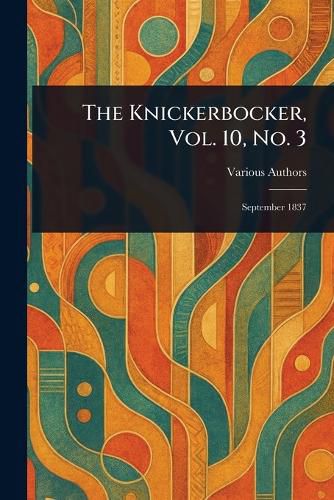Readings Newsletter
Become a Readings Member to make your shopping experience even easier.
Sign in or sign up for free!
You’re not far away from qualifying for FREE standard shipping within Australia
You’ve qualified for FREE standard shipping within Australia
The cart is loading…






This title is printed to order. This book may have been self-published. If so, we cannot guarantee the quality of the content. In the main most books will have gone through the editing process however some may not. We therefore suggest that you be aware of this before ordering this book. If in doubt check either the author or publisher’s details as we are unable to accept any returns unless they are faulty. Please contact us if you have any questions.
Step back in time with "The Knickerbocker, Vol. 10, No. 3, September 1837," a fascinating window into 19th-century American literature and culture. This meticulously reproduced periodical offers a diverse collection of essays and writings, capturing the spirit of the era.
Explore a range of literary collections, historical perspectives on the United States, and biographical sketches, all within the pages of this single magazine issue. "The Knickerbocker" provides a valuable glimpse into the intellectual and social landscape of the time, showcasing the voices and opinions that shaped American thought.
This volume serves as a primary source for understanding the literary tastes and historical concerns of 1837. A treasure for anyone interested in American history, literature, or the evolution of periodical publishing.
This work has been selected by scholars as being culturally important, and is part of the knowledge base of civilization as we know it.
This work is in the public domain in the United States of America, and possibly other nations. Within the United States, you may freely copy and distribute this work, as no entity (individual or corporate) has a copyright on the body of the work.
Scholars believe, and we concur, that this work is important enough to be preserved, reproduced, and made generally available to the public. We appreciate your support of the preservation process, and thank you for being an important part of keeping this knowledge alive and relevant.
$9.00 standard shipping within Australia
FREE standard shipping within Australia for orders over $100.00
Express & International shipping calculated at checkout
This title is printed to order. This book may have been self-published. If so, we cannot guarantee the quality of the content. In the main most books will have gone through the editing process however some may not. We therefore suggest that you be aware of this before ordering this book. If in doubt check either the author or publisher’s details as we are unable to accept any returns unless they are faulty. Please contact us if you have any questions.
Step back in time with "The Knickerbocker, Vol. 10, No. 3, September 1837," a fascinating window into 19th-century American literature and culture. This meticulously reproduced periodical offers a diverse collection of essays and writings, capturing the spirit of the era.
Explore a range of literary collections, historical perspectives on the United States, and biographical sketches, all within the pages of this single magazine issue. "The Knickerbocker" provides a valuable glimpse into the intellectual and social landscape of the time, showcasing the voices and opinions that shaped American thought.
This volume serves as a primary source for understanding the literary tastes and historical concerns of 1837. A treasure for anyone interested in American history, literature, or the evolution of periodical publishing.
This work has been selected by scholars as being culturally important, and is part of the knowledge base of civilization as we know it.
This work is in the public domain in the United States of America, and possibly other nations. Within the United States, you may freely copy and distribute this work, as no entity (individual or corporate) has a copyright on the body of the work.
Scholars believe, and we concur, that this work is important enough to be preserved, reproduced, and made generally available to the public. We appreciate your support of the preservation process, and thank you for being an important part of keeping this knowledge alive and relevant.